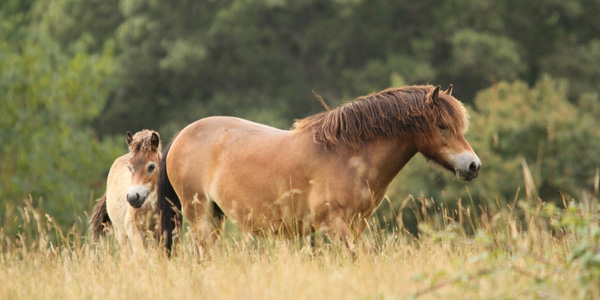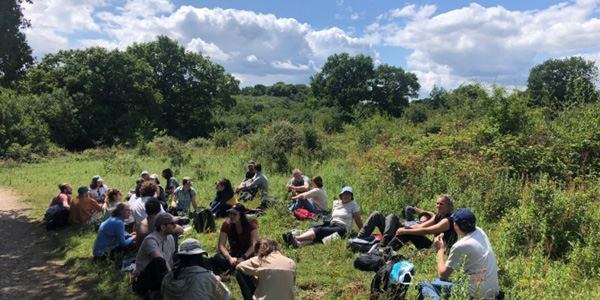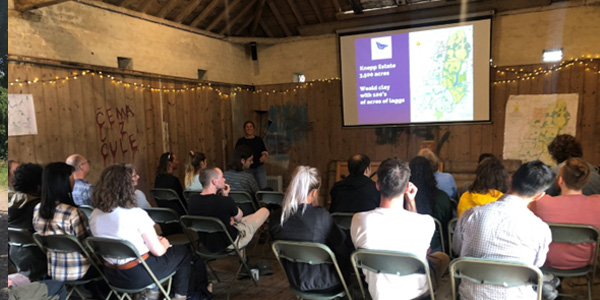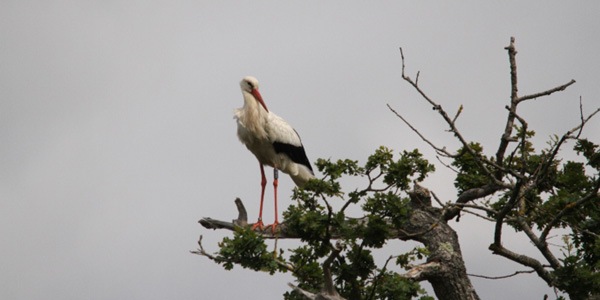A walk on the (re)wild side
Postdoctoral researcher, Hanna Pettersson, looks back on her first year with the Leverhulme Centre for Anthropocene Biodiversity and discusses the contemporary topic of Rewilding.

3 October marks the first anniversary of my postdoc here at LCAB. Reflecting back on this year full of debates, writing, trips, training, and conferences, the file rouge is plain to see: rewilding. In a research centre focused on anthropocene biodiversity, this is perhaps not surprising. The topic has captured the public imagination at a truly impressive scale, with mounting piles of books and scientific papers, weeks' worth of TV programmes and podcasts, a rapidly accumulating number of initiatives large and small, and even a rewilding wine.
And as if that wasn’t enough, this year saw the launch of a rewilding shoe, complete with a sole designed to distribute seeds. As phrased by the rewilding thinker Paul Jepson: rewilding has entered the scientific and cultural mainstream.
I first became aware of rewilding over ten years ago. I was doing an undergrad in Global Studies in Sweden, and, through a curious twist of events, found myself in a snow-piled forest with the task of measuring a seemingly never-ending number of trees. A keen eye would have noticed that it was no usual forest. Some of the trees had gruesome injuries, cunningly devised to mimic lightning strikes, the pecking of a woodpecker, the coppicing of a human hand. This was the Eco park, a project to restore “the cultural landscape” around the zoological park Nordens Ark. A part of it involved coaxing a former plantation into the shape and function of a woodland pasture, a once common and highly biodiverse habitat across Europe. To their help they had deployed an army of traditional cattle breeds, people with an array of sharp tools, me with my callipers, and, since a few years back, a group of European bison. The project was inspired by Franz Vera, the bold biologist behind Europe’s first large-scale rewilding experiment: Oostvardesplassen in the Netherlands. And despite my cold fingers and a growing desire to never measure another tree in my life, I too was inspired.
How fitting that ten years later, in July this year, I find myself frolicking amongst the shrubs and cow pats of an equivalent project in the UK: the Knepp estate in West Sussex. Well, to be completely accurate, it was my colleagues doing the frolicking. As the self-declared organiser, I spent my time trying (mostly in vain) to keep the group from scattering, stopping and stooping, a bit like a border collie with an unruly flock of sheep. A common predicament when you take a group of 24 plant, bird, and insect enthusiasts on a field trip to a famous rewilding site.

The field trip gang, successfully herded together for a well-deserved lunch in the shrub. Photo by Hanna Pettersson.
The Knepp (re)wilding endeavour was initiated by Sir Charlie Burrell and his wife Isabella Tree upon resigning to the fact that conventional farming on these heavy clay soils was not, despite their best efforts, financially viable. The year was 2001, they had received funding from the Country Stewardship Scheme to restore some of the estate’s parkland, and they had read a book on grazing ecology that had recently been translated into English. The author, you guessed it, was Franz Vera.
Today, Knepp is known as “a trailblazing 3,500-acre rewilding project that has changed the way we think about nature and how we can heal our planet”. It is home to the UK's largest population of purple emperor butterflies; a breeding hotspot for nightingales and turtledoves; and a reintroduction site for white storks, beavers, and, if all goes to plan, European bison. This impressive feat has been achieved through the grazing, trampling, wallowing and gnawing of Longhorn cattle, red and fallow deer, Tamworth pigs and Exmoor ponies.
Thanks to their success in increasing biodiversity and reinventing themselves as a nature tourism destination, and to Isabella’s popular book about their journey, Knepp has become widely influential and used as a proof of concept for rewilding. We at LCAB were of course curious to explore what all this meant on the ground.

A fascinating presentation by resident ecologist Pen Green in the old dairy at Knepp.
We began our visit with a presentation by Penny Green, Knepp’s wonderfully hospitable and knowledgeable ecologist. She illuminated how the land had transformed, current approaches to management, and plans for the estate. This was followed by a presentation by Benedict Dempsey, now at the WWF, who did research at Knepp exploring the notion of control in conservation. To me, this was particularly interesting since the approach at Knepp is often described as “relinquishing control to nature” and being “open-ended”. However, as explained by Pen and Ben, and as we were able to observe over our two days at the estate: human intervention was both pervasive and necessary. A prominent example is the reintroduction of species, which is far from straightforward given how the land, climate, and public opinion have changed. Another is the active control of stock numbers and grazing pressure, both to manage stock health and the appearance of the landscape. This makes complete sense, given the animals cannot disperse beyond the estate boundaries and lack carnivores which might naturally regulate their numbers. The very basis of the wood pasture landscape, at least since the Neolithic revolution, has been the active intervention of people and their livestock. As some would argue, human control is inherently natural.

One of the newest residents at Knepp: a white stork, ringed and carefully monitored by Knepp staff and researchers. Photo by Helen Mylne.
Together with an excellent third presentation by Chris Sandom on multi-criteria mapping of different land uses, and a walk around the grounds with landscape geographer and historian Geoffrey Mead, it became obvious to us that rewilding is simply a different manifestation of control: with its own set of rationales, intended outcomes and challenges. This is by no means unique to Knepp, but also true for places like Oostvardesplassen, Yellowstone in the US, or the Ibera Wetlands in Argentina. It is important to remember that even abstaining from intervention represents a choice, impacting humans and non-humans in different ways, with clear winners and losers.
At the end of the jam-packed field trip, which also featured visits to South Downs National Park and the Weald and Downland Museum, happy and tired LCAB researchers piled back into their cars, brimming (at least in my case) with even more inspiration and ideas for future explorations.